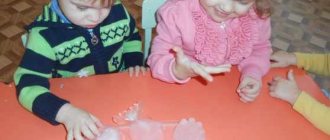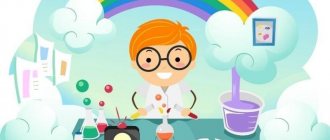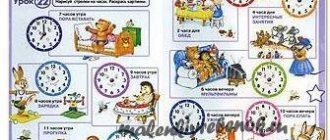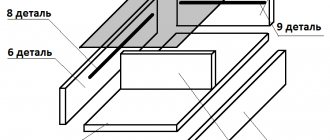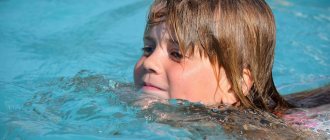Notes on experiments with sand for younger children
Brief summary.
For children with impaired vision, the development of other, intact analyzers is very important. One of the ways for children with disabilities to explore the world is through experimentation.
This material may be useful for teachers of general education preschool educational institutions and for parents of younger preschoolers.
Experimenting with sand (younger age).
Goal:
to introduce children to the properties of sand, to develop the ability to concentrate; systematically and consistently examine objects, the ability to notice individual details of the overall picture; develop children's observation skills, ability to compare, establish basic cause-and-effect relationships and draw simple conclusions. Introduce safety rules when conducting experiments.
Materials for experimentation:
container with sand, water, stencils, molds, cocktail straws, plastic transparent container (jar).
Experiment 1. “Sand House”
Take a handful of sand and release it in a stream so that it falls in one place.
Gradually, a cone forms at the site of the fall, growing in height and occupying an increasingly larger area at the base. This will be our house. If you pour sand for a long time, drifts (sand rivulets), sand movements similar to a current, appear on the surface of the cone, now in one place, then in another. Children conclude: dry sand is free-flowing and can move. Experiment 2. “Footprints on wet sand”
Wet sand cannot be poured out of the palm of your hand, but it can take any desired shape until it dries. Let's find out with the children why figures can be made from wet sand (working with molds) and leaving interesting imprints - traces (working with stencils).
Experiment 3. “Where is the water?”
Invite children to find out the properties of sand by testing it by touch (loose, dry).
Children pour cups with the same amount of water (pour just enough water to completely sink into the sand). Find out what happened in the container with sand, why the water left (seeped through the sand) where there are more puddles after the rain (there are no puddles on the asphalt, in the sandbox). Experiment 4. “Wind”
Invite children to find out why it is inconvenient to play with sand in strong winds. Children examine the prepared “sandbox” (a jar filled with a thin layer of sand). Together with adults, they create a hurricane - they blow into the sand into a tube and find out what is happening and why (since the grains of sand are small, light, do not stick to each other, they cannot hold on to each other or to the ground with a strong stream of air) .
Experiments with sand in the second junior group
Albina Shmitko
Experiments with sand in the second junior group
Experiments with sand in the 2nd junior group.
Goal: To develop the cognitive activity of children in the process of experimentation. To help expand children's knowledge about the properties of dry and wet sand .
Tasks:
Training tasks:
Help children better understand the inanimate world around them
Introduce children to the properties of sand .
Learn to handle sand carefully , do not spill it.
Teach children to draw their own conclusions based on examination results.
Developmental tasks:
Create favorable conditions for sensory perception
Develop skills of interaction with peers in the process of joint activities. Enrich your vocabulary.
Educational tasks:
To cultivate the moral qualities of a child during his communication with nature
To develop cultural and hygienic skills in children (neatness, neatness)
.
Experience No. 1 “Getting to know the sand ”
Purpose: to introduce sand , to draw attention to the properties of dry sand (it flows, does not get dirty)
Materials: cups of sand , sheets of white paper, magnifying glasses.
Experiment No. 2 “Does sand fall easily?”
Goal: Learn to pick up sand and hold it in your palms, pour it in a thin stream
Material: trays with sand .
Experience No. 3 “Hide and Seek”
Goal: To teach children to bury (get)
toys in dry
sand , and hide the toys by immersing them in the sand.
Material : sand
Experiment No. 4 “Find objects”
Goal: learn to sift sand through a sieve.
sand center , strainer, small objects (pebbles, beads, etc.)
Experiment No. 5 sand in strong winds ”
Goal: To consolidate knowledge about the properties of sand
Material: sandbox
- a jar with a thin layer
of sand , trays with sand , cocktail tubes.
Experiment No. 6 “Miraculous transformations of sand ”
Mothers: cups with sand and water .
The goal is to teach children to water dry sand from a watering can. Develop the ability to notice changes occurring in sand (Color, condition)
.
Experiment No. 7 “Sculpting from sand ”
Purpose: to introduce children to the properties of wet sand .
Material: trays with wet sand .
Experiment No. 8 “Wet sand takes any desired shape”
Goal: continue to introduce children to the properties of wet sand
Material: tray with wet sand , various molds.
Experiment No. 9 “Whose trace”
Goal: To develop the ability to leave footprints in the sand , then determine what object left the trace.
Material: trays with wet and dry sand .
Experiment No. 10 “Drawing with sand ”
Target. Develop the ability to pour dry sand onto the adhesive pattern, then shake off the excess sand .
Materials: dry sand, sheets of paper with drawn pictures, glue sticks.
A long-term plan for experimental games with sand and water in the younger group
Transcript
1 Municipal government educational institution Steklyansky kindergarten Fairy tale of the Kupinsky district of the Novosibirsk region Long-term plan for games-experiments with sand and water in the younger group Teacher of the younger group: Volodina V.N.
2 October Let's pour, sculpt To form knowledge about the properties of dry and wet sand. 1. Teach how to examine material (squeeze sand in your hand and pour it out of your palm) 2. Develop visual-auditory connections, fine motor skills, coordination of movements. 3. Foster a positive attitude towards elementary experimental activities. 1. . 2. Sand molds. About a small drop Introduce children to the properties of water. 1. To develop in children the skill of practical experimentation with different objects from different materials. 2. Develop an active vocabulary. 3. Foster a positive attitude towards the character Droplet. 1. A cap toy (a blue balloon inflated in the form of a drop) 2. 2 basins of water (cold, warm) 3. A jar of dirty water. 4. Home fountain 5. Clean boiled water, cups. 6. Transparent disposable cups. 7. Colored sponges 8. Floating toys. November Our handprints To consolidate children's knowledge about the property of wet sand - to retain the shape of an object. 1. Teach children to make palm prints, fist prints, and palm edges. 2. Develop imagination and creativity. 3. Cultivate a positive attitude towards your work and the work of your comrades. 2. Multi-colored pebbles.
3 Sinks, does not sink, floats Introduce children to the properties of rubber and stones. Rubber is light and floats in water. The stone is heavy and sinks. 1. Teach children to act with rubber toys, natural materials, pebbles. 2. Develop the ability to recite a familiar nursery rhyme and demonstrate it using finger exercises. 3. Foster a positive attitude towards the character. 1. Center - water sand. 2. Small rubber balls according to the number of children. 3. Multi-colored pebbles 4. Rubber duck. Visit the mouse Consolidate children's knowledge about the properties of water and sand 1. Develop the ability to recognize and name primary colors. 2. Develop gross and fine motor skills. 3. Foster a positive attitude towards elementary research activities. 1. . 2. Path. 3. Movable mouse. 4. Little mice according to the number of children. 5. Colored boxes. 6. Bochata inserts. 7. Apricot pits, white and red beans, peas, seeds. 8. Small plates. 9. Red and blue basin. Our feet walk along the level path. To develop in children the skill of practical experimentation with different objects from different materials. 1. Teach children to act with natural materials. 2. Develop visual-auditory connections, fine motor skills, and coordination of movements. 3. Cultivate cognitive interest in the world around us. 1. Pebbles of different sizes 2. Feathers 3. Basin with water 4. Buckets
4 December River and stream Consolidate children's knowledge about the property of sand - to hold water. 1. Form the concepts of “wide”, “narrow”, “big”, “small”. 2. Develop imagination and creativity. 3. Cultivate accuracy in work and a desire to play alongside friends. 2. Narrow and wide scoop. 3. Measuring cups. 4. Bucket of water. 5. Large and small paper boats. Multi-colored water To form children's understanding of the properties of water is the possibility of coloring. 1. Learn to name primary colors. 2. Develop fine motor skills of the hands. 3. Cultivate a positive attitude towards elementary research activities. 1. Capitoshka toy. 2. Disposable cups of water. 3. Gouache paints. 4. Carrot juice. January Minks for hedgehogs To consolidate children's knowledge about the properties of dry and wet sand. 1. Form an idea of quantity (one-many, size (large-small). 2. Develop the ability to display in speech using prepositions (on, under) the location of objects. 3. Develop gross and fine motor skills, tactile sensations. 4. Cultivate a caring attitude to animals. 1. A toy hedgehog 2. Plasticine hedgehogs according to the number of children. 3. Pine needles in plates. 4.
5 Snowman visiting children Give an idea of the property of snow to turn into water. 1. To develop in children the skill of practical experimentation with different materials. 2. Develop fine motor skills and coordination of movements. 3. Foster a positive attitude towards the snowman character. 1. Toy snowman 2. Sand molds 3. Scoops 4. Trays 5. Colored pieces of ice 6. Clean snow in a basin February Slides for kids Teach children to lay out a mold from wet sand. 1. Develop knowledge about the height of an object - high, low. 2. Develop general hand motor skills and coordination of movements. 3. Cultivate goodwill and a desire to help. 2. Wooden theater set “The Wolf and the Seven Little Goats”. 3. Buckets large and small. How different water is Give an idea of the property of water to turn into ice. 1. Develop the ability to name primary colors. 2. Develop fine motor skills and coordination of movements. 3. Foster a positive attitude towards the character. 1. Molds from the bottoms of plastic bottles, 10-15 pieces. 2. Chocolate candy insert in a box. 3. Glass with clear water 4. Colored water in cups 5. Toy bunny March Foxy visiting the guys
6 Strengthen the ability to determine the properties of dry (crumbles) and wet (holds its shape) sand. 1. Teach children to scoop sand with a scoop and fill the mold. Strengthen the ability to use a sieve. 2. Develop gross and fine motor skills. 3. Cultivate a positive attitude towards the character, a desire to help. 4. Toy Fox. 5. Cord. 6. Large beads 15 pcs. 7. Sand in transparent glasses. (by number of children) 8. Sita (by number of children). 9. Molds, trays. 10. Watering can with water. Beads for a bear Give an idea about the properties and qualities of ice. 1. Form an idea of wild animals (hare, squirrel, bear). 2. Develop fine motor skills of the hands. 3. Cultivate responsiveness and goodwill. 1. Toys (hare, bear, squirrel). 2. Treats for animals (cabbage, carrots, pine cones, candy). 3. Colored beads made from ice floes. 4. Large wooden beads. 5. Cord for stringing beads. April Doll Masha's birthday Continue teaching children how to lay out shapes from wet sand. 1. To teach children to finish the words of a familiar fairy tale 2. To develop fine motor skills and coordination of movements. 3. Cultivate sympathy for the game characters, evoke a desire to help them. 2. The doll is big. 3. Table theater "Kolobok" 4. Molds. 5. Trays. 6. Scoops. 7. Great building material. Let's wash the doll's dress
7 To develop in children the ability to name the temperature of water. 1. Practice naming items of clothing and linen. 2. Develop an understanding of some labor actions and items necessary for washing (water, soap, basin). 3. Foster interest in the work activities of adults. 1. Doll 2. Basin 3. A bucket of hot and cold water. 4. Soap 5. Soap dish May We went to the garden To strengthen the children’s ability to lay out shapes from wet sand. 1. Learn to find vegetables hidden in the sand by touch and by name. 2. Develop tactile-kinesthetic sensitivity. The ability to dramatize a familiar fairy tale. 3. Foster a positive attitude towards the character. 2. Grandfather doll 3. Dummy vegetables (onions, garlic, beets, carrots, turnips). 4. Caps of the characters from the fairy tale “Turnip”. 5. Basket. 6. Molds, trays, scoops (according to the number of children) 7. Watering can with water. Bathing the Katya doll Strengthen the ability to determine and name the temperature of water “cold”, “hot”, “warm”. 1. Accustom children to use names of objects and actions with them in speech. 2. Develop the ability not to be distracted from the task at hand. 3. Develop cultural and hygienic skills and behavior. 1. Doll 2. 2 buckets of water (cold, hot) 3. Bath 4. Soap 5. Soap dish 6. Towel
Environmental project in the first junior group on the topic: “Magic Sand” (inanimate nature)
Environmental project “Magic Sand”
Type: short-term, research.
Goal: To satisfy children’s needs for activities with natural materials - for experimenting with sand.
Tasks:
Introduce children to the properties of sand (dry - wet, pours - molds). To promote the development of cognitive activity, curiosity, the desire for independent knowledge and reflection. Enrich the child’s sensory experience and develop fine motor skills. Cultivate accuracy in handling sand and the ability to play with peers nearby. Introduce the rules of the sandbox game.
Resources: sandbox, shovels and sand molds, water in children's watering cans, toys.
Participants: children, teachers, parents.
Relevance:
Federal state requirements for the preschool education program strongly recommend project-based and experimental activities. Of course, in relation to children of primary preschool age, project and experimental activities are largely simplified and are of a playful nature. Experimentation is a direct path to raising extraordinary, smart children.
Sand games for kids:
A) Allows you to cope with your emotional state, which is extremely important for children of primary preschool age.
B) Involve children in an interesting process of learning about the environment.
In this project, the object of study was dry and wet sand. Dry sand does not retain its shape - it crumbles. And wet sand retains the shape of the container in which it was placed.
An important point in the project was the question of how to get wet sand from dry sand (rain or watering the sand).
The project is designed for 3 days. When planning the work, the principle of integration of educational areas was taken into account.
Since the children are small, joint activities between children and the teacher took a significant place in planning. The teacher guided the children, surprised them, and created an atmosphere of intrigue and search for solutions to problems.
Expected results: Formation of the ability to consciously perform actions with dry and wet sand. If necessary, add water to dry sand. Manifestation in children of elementary control over the method of action. Cultivating interest in the result and a sense of satisfaction from the activity.
Work planning
| Days of the week | Educated region | Image. daily activities | GCD | Independent activities of children | Working with parents |
| 1st day | Cognition Physical Culture Work | Morning: situational conversation “The Cockerel and the Duck.” Goal: find the leading difference between birds (a duck swims and dives). Walk: Outdoor game “Sun and Rain”. Goal: to teach to consciously act in accordance with the text of the game. | Observation of sand properties (dry and wet). Goal: to become familiar with the properties of sand (dry sand flows, wet sand retains its shape). | Watering sand in a sandbox using watering cans. Loosening with a spatula. Goal: mastering how to handle a watering can and spatula. | Consultations for parents: “Playing with water and sand”, “How to organize children’s search and cognitive activities.” |
| 2nd day | Reading art literature Cognition Socialization Work Communication | Morning: story reading V. Suteev “Chicken and Duckling”. Purpose: to encourage reflection on the plot of the story. Walk: didactic game “Stash”. Goal: learn to bury objects in the sand and dig them out. | Conducting experiments with sand. (Pour water over the dry sand). Pouring dry sand from a bottle. Goal: developing a household skill: pouring bulk substances from container to container. | Conducting experiments with sand. (Pour water over the dry sand). Pouring dry sand from a bottle. Goal: developing a household skill: pouring bulk substances from container to container. | Offer to water the sandbox in the yard of your house in the evening. Goal: to help children in the practical development of knowledge of the properties of sand. |
| 3rd day | Reading art literature Cognition Socialization Health Safety | Morning: Reading Marina Ershova’s poem “Sandbox”. Goal: to evoke an emotional response from a familiar environment. Walk. A conversation about careful handling of sand. Goal: to teach children to avoid situations where sand gets in the face of themselves and their friends. | Problem situation: “Let's help the doll Antoshka. Sand hit him in the face." Goal: to form ideas about unwanted sand getting into a person’s eyes. | Games in the sandbox with molds and shovels. Goal: To consolidate ideas about the properties of sand. | Playing with sand - making pies and cookies using molds. Goal: creating favorable conditions for joint activities of children and the teacher; strengthening the skills of playing with sand. |
Photographic materials.
Get text
